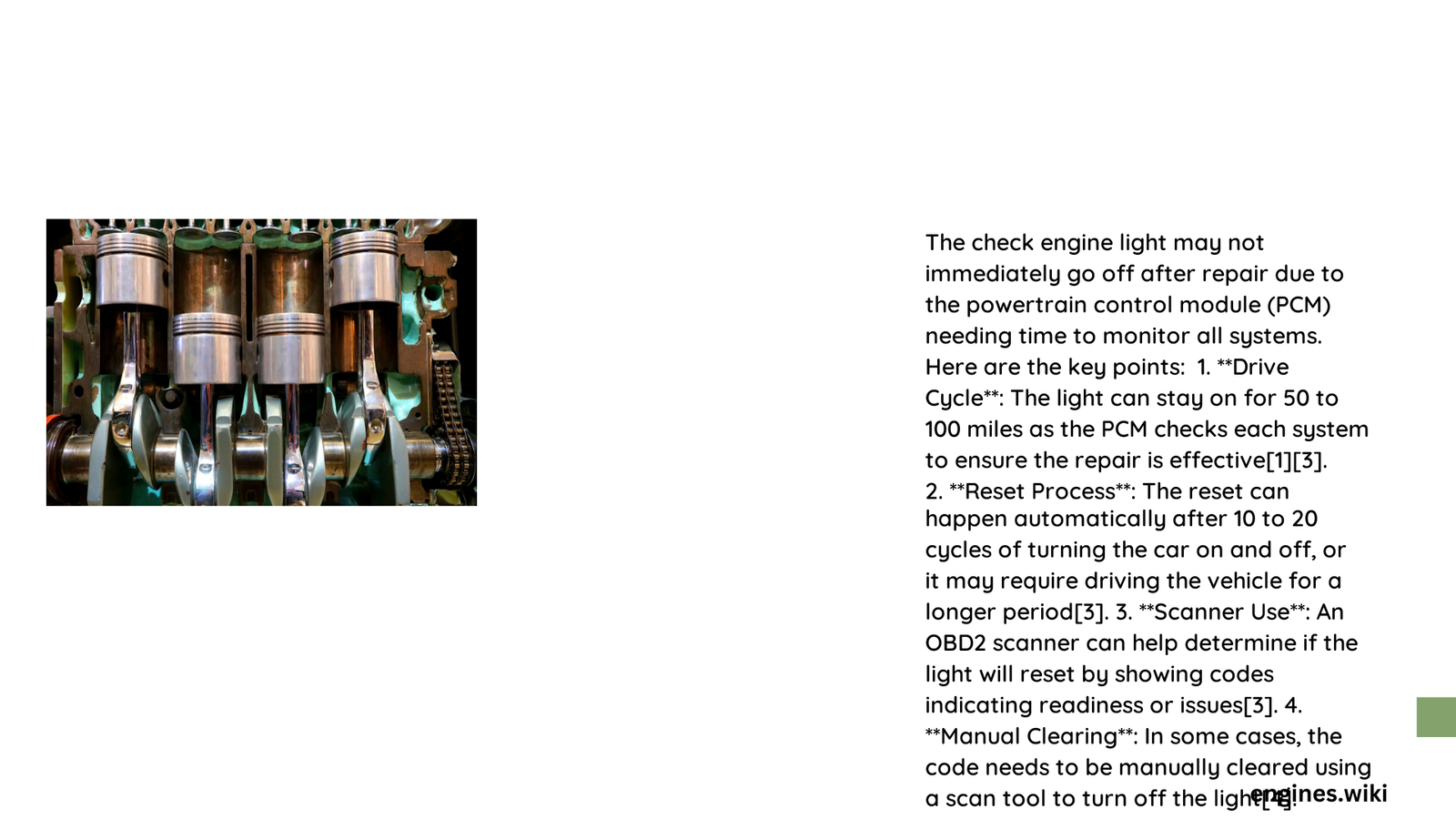When your vehicle undergoes repairs, the persistent check engine light can be frustrating and confusing. Understanding why this warning indicator remains illuminated requires comprehensive knowledge of automotive diagnostic systems. The light may not automatically extinguish after repairs due to complex computer monitoring processes, incomplete system readiness checks, or unresolved underlying mechanical issues that need specific reset procedures.
Will the Check Engine Light Automatically Reset After Repair?
How Do Computer Systems Determine Light Reset?
Vehicle computer systems (ECM/PCM) use sophisticated diagnostic protocols to manage warning indicators. Unlike simple on/off switches, these systems require specific conditions to clear diagnostic trouble codes (DTCs):
| Reset Method | Complexity | Success Rate |
|---|---|---|
| Manual Reset | High | 85-90% |
| Drive Cycle | Medium | 70-80% |
| Scanner Reset | High | 95-98% |
What Prevents Immediate Light Deactivation?
Several critical factors influence check engine light persistence:
- Incomplete Readiness Monitors
- Emissions system verification
- Multiple driving cycle requirements
-
Specific temperature and speed conditions
-
Unresolved Diagnostic Codes
- Partial repair execution
- Intermittent mechanical issues
- Complex sensor interactions
How Can You Effectively Reset the Check Engine Light?
OBD2 Scanner Method
- Connect professional diagnostic tool
- Navigate diagnostic menu
- Select code clearing option
- Confirm system reset
- Verify light extinction
Battery Disconnection Technique
- Locate vehicle battery
- Disconnect negative terminal
- Wait 10-15 minutes
- Reconnect battery
- Start vehicle
- Observe dashboard indicators
What Are Common Scenarios Preventing Light Deactivation?
Persistent Issues Requiring Attention:
– Oxygen sensor malfunction
– Catalytic converter problems
– Loose gas cap
– Electrical system irregularities
– Incomplete repair procedures
Expert Recommendations for Check Engine Light Management
✅ Recommended Actions
– Use professional diagnostic scanner
– Complete full manufacturer-recommended drive cycle
– Verify all repair components
– Check for pending diagnostic codes
– Consult certified automotive technician
Technical Insights for Vehicle Owners
Modern vehicles utilize complex computer systems that require precise reset procedures. Simply turning off the engine or disconnecting the battery might not guarantee immediate light deactivation. Professional diagnostic tools provide the most reliable method for comprehensive system reset.
Potential Risks of Ignoring Check Engine Light
⚠️ Warning Indicators
– Potential performance degradation
– Increased fuel consumption
– Risk of additional mechanical damage
– Potential emissions system failure
– Reduced vehicle efficiency
When Should You Seek Professional Help?
- Multiple reset attempts fail
- Recurring diagnostic codes
- Complex electrical system issues
- Advanced vehicle models
- Lack of diagnostic equipment
Final Diagnostic Recommendations
- Use professional OBD2 scanner
- Complete manufacturer-recommended drive cycle
- Verify all repair components
- Monitor system performance
- Consult certified technician if issues persist
Pro Tip: Modern vehicles require specific reset procedures that vary by make and model. Always consult your vehicle’s manual or a professional technician for precise guidance.
Conclusion
Understanding check engine light reset procedures requires technical knowledge and systematic approach. While multiple methods exist, professional diagnostic tools and comprehensive repair verification remain the most reliable strategies.

